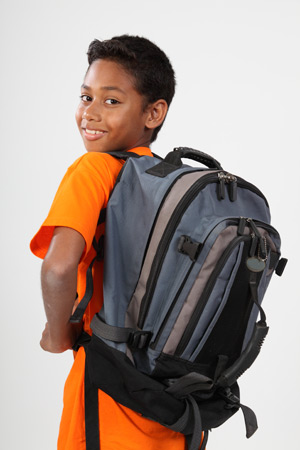Overview
Children often use backpacks to carry school supplies to and from school. If used properly, backpacks are designed to distribute weight evenly without strain to neck, shoulder or back muscles.
Common injuries
- Muscle strain in the neck, shoulder or back, particularly if the backpack is too heavy or is being carried by only one of the straps
- Numbness or tingling associated with thin straps, too much weight in the back pack or carrying the pack by one strap
- Tripping over a backpack because of its bulky size in tight corridors
Backpacks may cause pain, but they don’t cause scoliosis. Scoliosis is a curve in the spine that may show up in children in junior high or high school. The myth that backpacks cause scoliosis has never been proven. Carrying a backpack on one shoulder does not cause scoliosis, and better backpack mechanics will not cure or improve scoliosis.
Some backpacks have wheels. Rolling backpacks may cause less strain, but they are hard to use properly on stairs or crowded hallways.
Recommendations
- Check frequently that your child is not carrying more than 15% of his or her body weight in the backpack.
- Encourage your child to bring only necessary books and materials home each night.
- Ask your child if he or she can store items in a locker rather than the backpack.
- Educate your child about proper backpack wear. Keep straps on both shoulders and use the waist strap. Adjust straps to fit snugly.
- Help your child understand how to distribute the weight properly. Put the heaviest items low and near the center of the back.
Recommendations from the American Academy of Pediatrics for choosing the correct backpack include:
- Choose lightweight. Consider your child’s weight and carrying needs. The full backpack should not exceed 15% of his or her body weight.
- Shoulder straps should be wide and padded to avoid poor distribution of weight.
- Choose sturdy material to prevent sharp objects from poking through.
- Use a waist belt to hold the pack close to the body.
- Multiple compartments can help with organization and also to distribute the weight evenly.
More Information
Q: My teen complains of back pain. Is it from carrying a heavy backpack?
Backpacks are a common and convenient way to transport school materials back and forth. If used properly, they should not cause back pain. Poor technique is common and an overloaded backpack, carried incorrectly, can strain the muscles.
Q: Is there a correct way to carry a backpack?
Yes. Good backpacks are designed to distribute the weight on both shoulders by using both straps. Heavy loads can be further supported by a waist strap and separate compartments to distribute the contents evenly.
Q: Are there weight limitations for school back packs?
It is good practice to minimize the weight in a backpack. The weight of the full backpack should not exceed 15% of your child’s weight.
Q: How do I choose the right backpack for my child?
The American Academy of Pediatrics recommends:
- Lightweight. A full backpack should not exceed 15% of your child’s weight.
- Shoulder straps. Look for wide and well-padded straps for comfort and even distribution of weight.
- Material. Pick a durable, sturdy material to prevent sharp objects from poking through.
- Waist belt. This helps keep the weight close the body.
- Multiple compartments. These distribute the weight evenly.
Q: My daughter was diagnosed with scoliosis. I am convinced it is because of her backpack. Am I correct?
Scoliosis is a curvature of the spine that occurs more commonly in girls than boys. Children with a 10-degree curve or greater may be treated by an Orthopedic surgeon. Depending on the age at discovery and the magnitude or type of the curve, that treatment may consist of observation, bracing or surgery. There is nothing to suggest that any particular activity, including carrying a backpack, contributes to scoliosis. Changing the backpack will not impact an existing curve for the better or the worse.

 POSNA.org
POSNA.org
